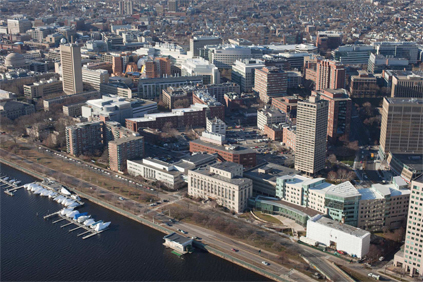Projects

East campus/Kendall gateway urban design study
As recommended by the Faculty Task Force on Community Engagement in 2030 Planning, MIT commissioned an urban design study to help us envision the future of our east campus and the Kendall gateway area. An important element of the study process was the gathering of thoughts and ideas from the MIT and Cambridge communities.
Review presentation materials
and ideas shared at
the community forums
Forum materials
Community participation is key
Kendall Square is a place where diverse people work, live, study, and play. Its optimal future can only be realized through a serious exploration that involves the active participation of its community members. Therefore, we are committed to advancing plans for the east campus through an interactive, thoughtful process that is highly collaborative and inclusive. Through a series of community forums we engaged and examined a rich variety of viewpoints on the road to a unique and inventive solution for this area. We believe community participation is the key to ensuring that the evolution of Kendall Square is inspired, sustainable, and satisfying to all. We received many interesting and creative ideas through this process and are now developing options to move forward.Goals of the study
The goal of the East Campus Urban Design Study is to help MIT create a long-range development framework that shapes future academic, residential, and commercial uses for its properties in the Kendall Square area. The initiative also seeks to create a vibrant gateway into MIT’s east campus.
Goals for the project include:
- creating a gateway that is emblematic of MIT in the 21st Century, and engages and enriches Kendall Square;
- enhancing the existing Kendall Square innovation cluster by providing space for new innovative academic initiatives and commercial enterprises;
- creating a lively and sustainable urban environment by developing a destination gathering and arrival place with amenities and services and active streetscapes for all;
- establishing a vibrant new gateway and connective links between MIT, the central business district, and the Cambridge community; and
- creating an overall development plan that is comprehensive, feasible, and economically viable.
Background
In 2009, MIT began working with Elkus|Manfredi Architects to create a conceptual approach to development in the east campus. Over the next three years, the Institute engaged in a community-wide effort to align the interests of a broad group of stakeholders around a future vision for the area.
In October 2012, the Faculty Task Force on Community Engagement in 2030 Planning, appointed by Provost Chris Kaiser, recommended that a comprehensive urban design plan for the east campus be completed if and when MIT received zoning approval for this area from the City of Cambridge.
The Cambridge City Council approved MIT’s rezoning petition for new development around Kendall Square in April 2013. The Council’s approval gives MIT the ability to propose over a million square feet of new development—a combination of housing, retail, lab, commercial, and open space. MIT also continues to have the right to pursue 800,000 square feet of new academic development.
Current process
Following the Cambridge rezoning decision in April 2013 and in response to the recommendations of the Task Force on Community Engagement, Adèle Santos, dean of the School of Architecture and Planning (SA+P), led a faculty design group through an informal exploration of design typologies for a Kendall Square initiative. Building on the work of the three-year community process, the group focused primarily on developing additional design goals and planning principles that should be achieved in future urban-design proposals.
In the Fall 2013, MIT commissioned an urban design study and assembled a team lead by Mack Scogin Merrill Elam Architects and Michael Van Valkenburgh Landscape Architects. The team used the analysis developed by Elkus|Manfredi Architects and the City of Cambridge during the rezoning effort and the work of the SA+P’s faculty design group in addition to input from the community as a foundation for developing its concepts. After hosting a series of forums to gather MIT and Cambridge community ideas, the design team submitted their final report in March 2014. (Links to report provided below.)
A steering group, co-chaired by Provost Schmidt and Executive Vice President and Treasurer Israel Ruiz, will guide the next steps in the context of the recent findings of the Graduate Student Housing Working Group. (The Working Group issued their final report in May 2014.)
In a July 2014 letter to the MIT community, Provost Schmidt, together with President Rafael Reif, Chancellor Cynthia Barnhart, and Executive Vice President and Treasurer Israel Ruiz, recommended that MIT advance a proposal for the future of the East Campus and Kendall Square area. The letter outlines the proposal to achieve the vibrancy and integration that is essential for this critical gateway area of the campus. Next steps include issuing Requests for Proposals for design teams to create building concepts for the East Campus that will be reviewed by senior leadership and brought through the City’s review process.We invite you to share your thoughts on the future of MIT’s east campus.
If you have any questions regarding this effort or next steps, please contact us at mit2030info@mit.edu.
Final report of the East Campus Urban Design Study
- Report: [Part 1 PDF], [Part 2 PDF], [Part 3 PDF]
- East Campus Urban Design Study: Appendix A - Sustainability Report [PDF document]
East Campus / Kendall Square update, July 2014
- Letter from Provost Schmidt to the MIT community advances proposal for East Campus and Kendall Square area
Review materials and comments shared at the community forums

